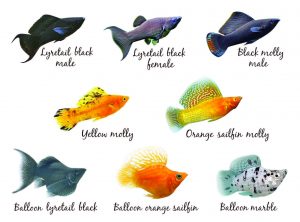Tropical fishes are popular because of their shape, color, and behavior. Fish stores seem incomplete without the live bearer group of fish. Guppies no doubt remain the trendiest of all. They move fast, have graceful tails, and a wide range of patterns and colors. Swordtails and Platys also have a wide variety of colors.
The mollies are peculiarly popular since they contradict the elements of popularity for an aquarium fish. They swim in a regular way, have basic body shapes, and their colors are generally standard in comparison to their swordtail and platy cousins.
Black mollies were the very first aquarium fish given to me by my uncle Teodoro Sun. The deep black color aroused my curiosity. Without an aquarium tank, I placed my mollies in a small plastic container with a volume of about less than a gallon. Daily, I would watch and feed them. The size of the tank is very important since black mollies can grow more than 3 inches and are active swimmers. Small containers can quickly stress them out, causing them to jump out or die.
Mollies are American fish, found in Central America and the Southern United States. While many fish in this genus can be found in the wild, aquarists have kept three main types for decades.
These are:
- Poecilia sphenops – Common or Short-finned Molly
- Poecilia latipinna – Sailfin or Topsail Molly
- Poecilia velifera – Mexican Sailfin Molly To further understand them:
- Poecilia represents multiple colors
- The Sphenops wedge represents appearance
- Latipinna represents broad fins
- Velifera represents sail-bearing fish
Mollies have been popular in the aquarium hobby for decades. The Black Molly, a striking fish with pure jet-black coloration, remains the most popular. They originated from hybrids between Poecilia sphenops and the sailfin molly. They sometimes have a streak of yellow on the dorsal fin and silver color on the flanks.
Other popular molly colors are yellow and marble. Round and lyre tails are available. They can also tolerate high salinity water, and do well in both brackish and freshwater tanks. Many hobbyists prefer to add regularly. In my experience, maintaining a high pH stabilizes the molly’s condition.
These are generally active fish with a lot of personality. They are entertaining to watch as they explore their surroundings and swim around the aquarium. For me, the molly does not entice as many fish lovers compared to swordtails and platys. It’s a case of, either the hobbyist is hooked on them or not. For me, they are worth trying to care for and experience.
Recently, I acquired yellow mollies. I find their color dull, and I feel it is not comparable to the depth of the color of the black molly.
Breeding Molly Fish
The molly fish is a livebearer, which means that its eggs are internally developed and fry are released. The size of the fry is larger compared to its platy and swordtail cousins. In my experience, mollies have an appetite for eating their young.
In a tank, a good ratio of three females and one male is advisable since males have a tendency to be territorial and aggressive.
Highly dense and floating plants are a great way to ensure the survival of the fry. Suggested plants are Java ferns, Amazon Sword, Java moss, duckweed, cabomba, and elodea.
The growth rate of mollies is quite fast, so the fry will be able to take care of themselves after a few weeks. I do not recommend using commercial breeding traps available in the market. I find the size and behavior of the molly places great stress on the female.
I have tried taking care of balloon mollies but reverted to caring for the normal sized mollies since balloon mollies lack the behavior I admire in the regular mollies.
In other countries, mollies are popular feeder fish due to their fast growth rate, birth size, rapid reproduction rates, and large brood numbers. Here in the Philippines I seldom see the use of mollies as feeders.
This appeared in Animal Scene magazine’s September 2017 issue.






